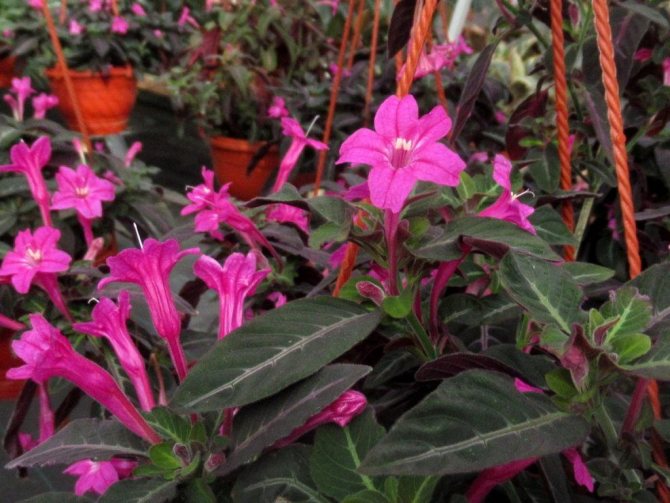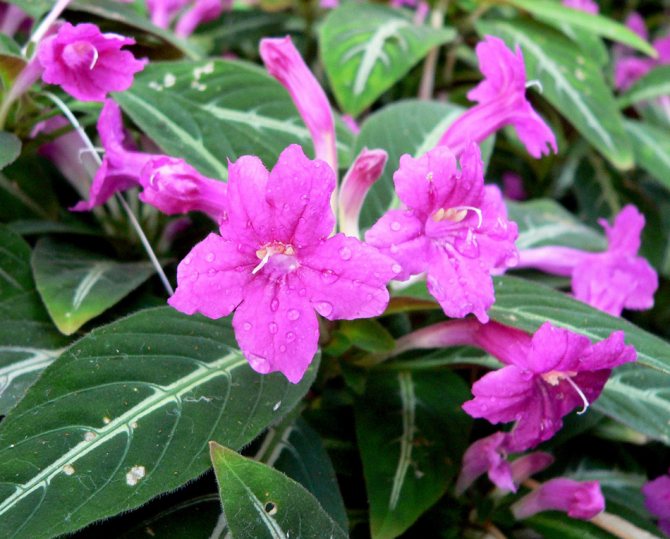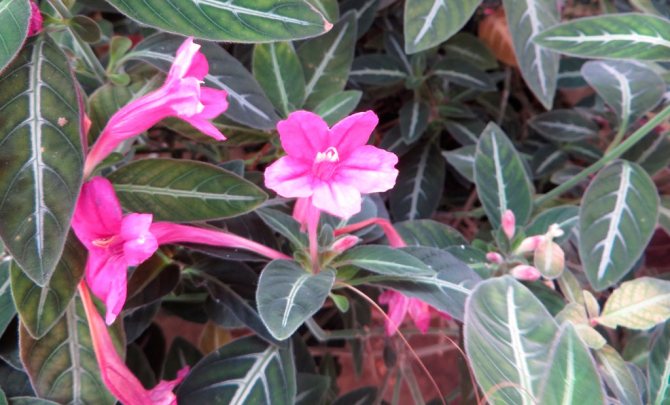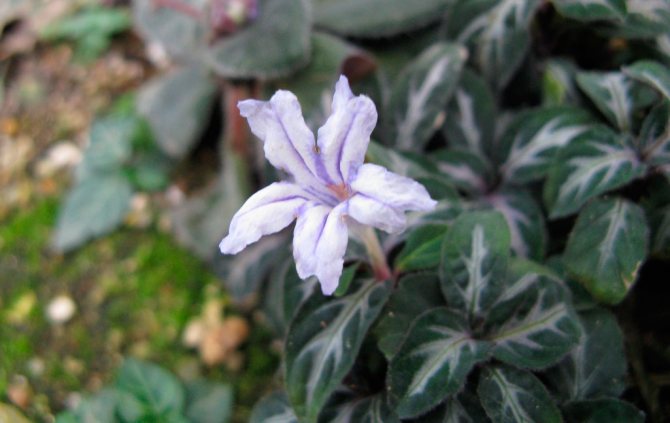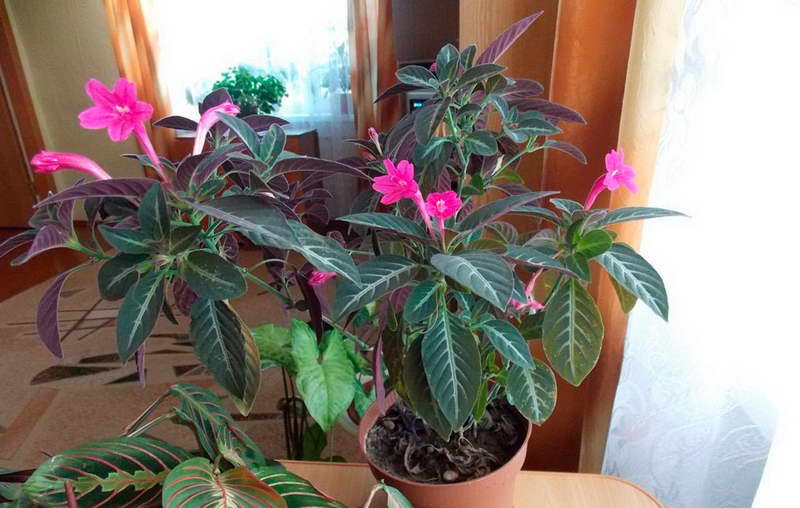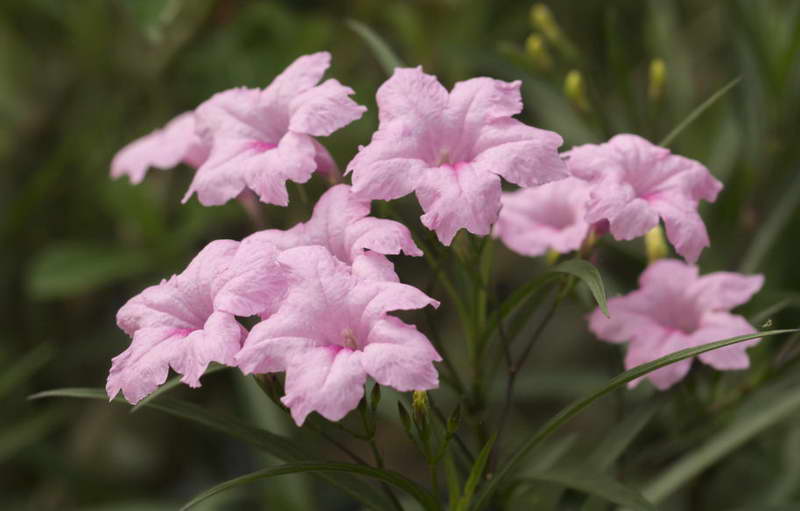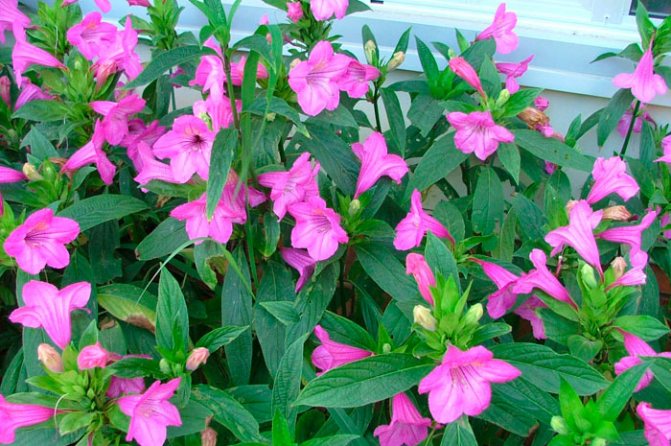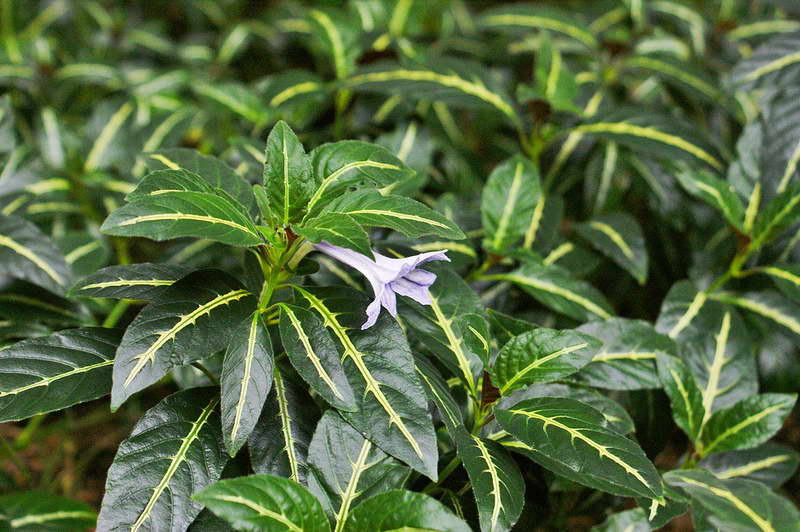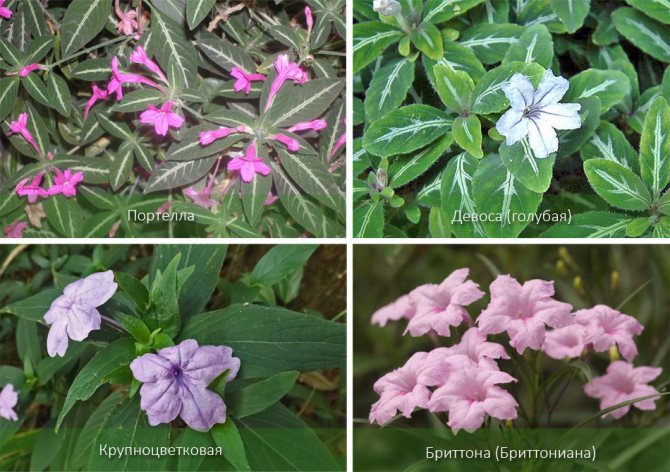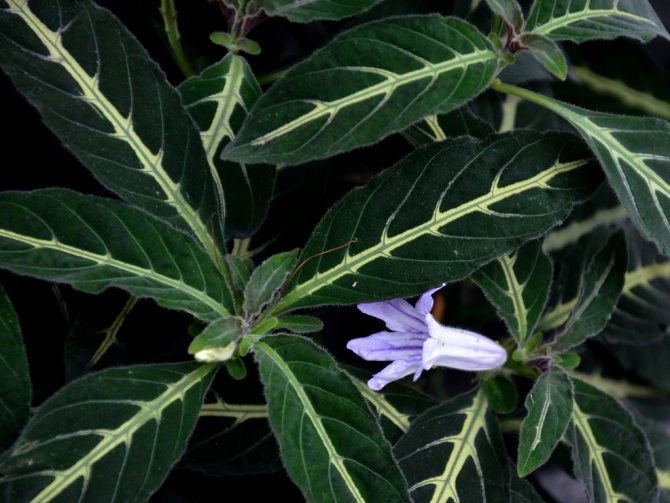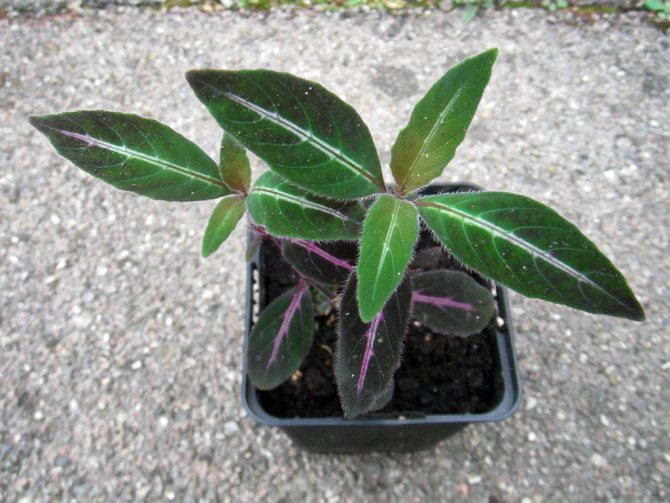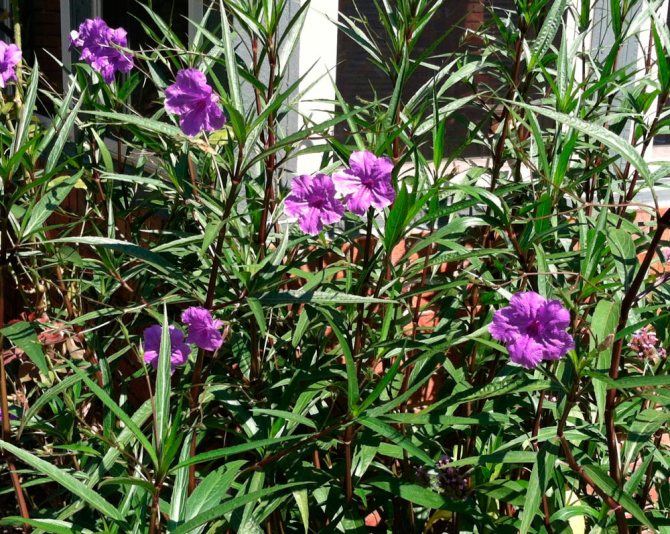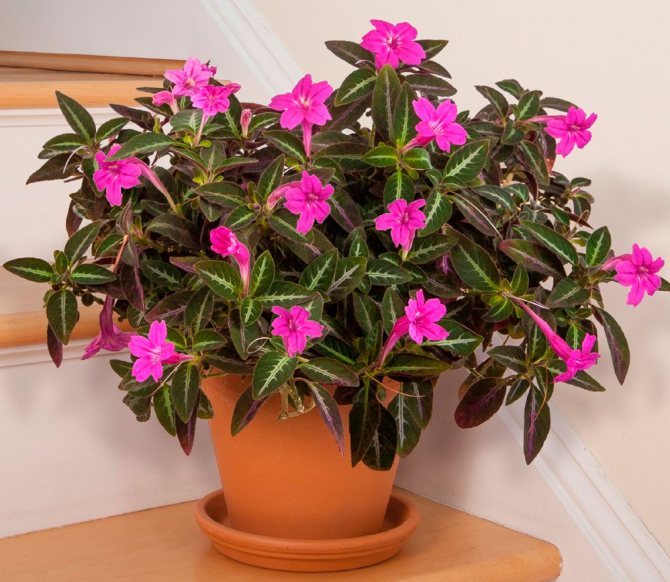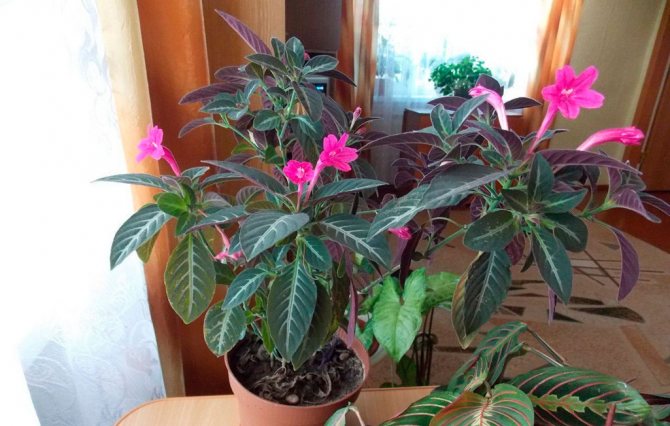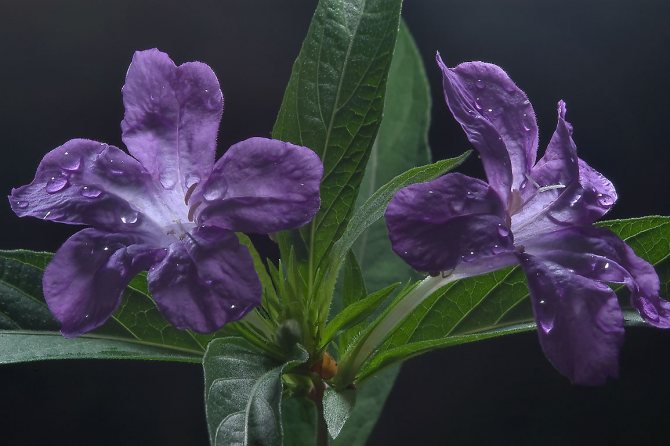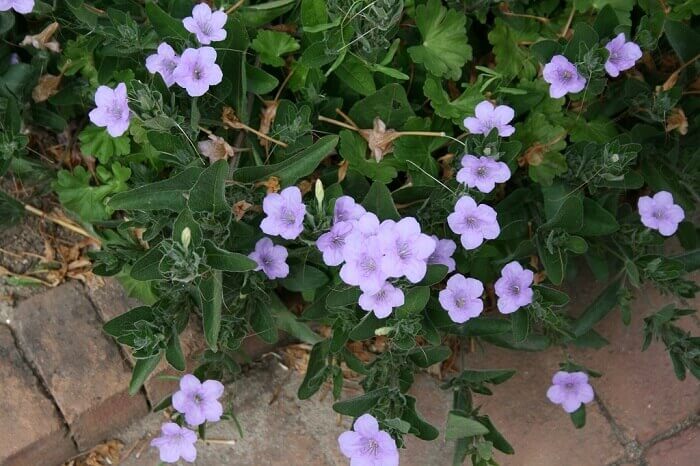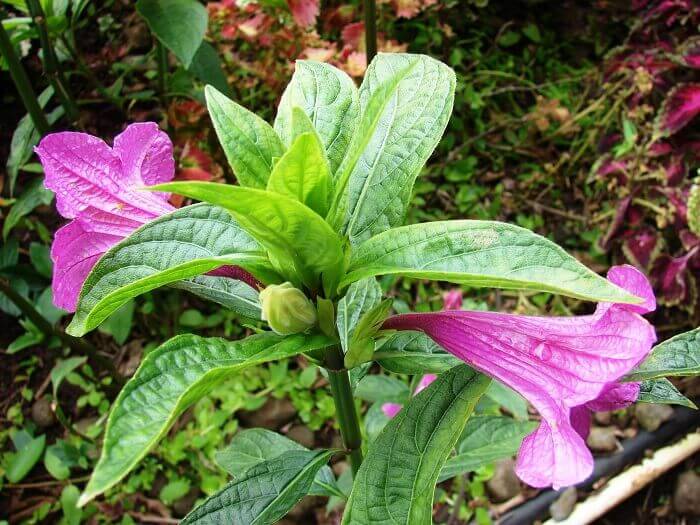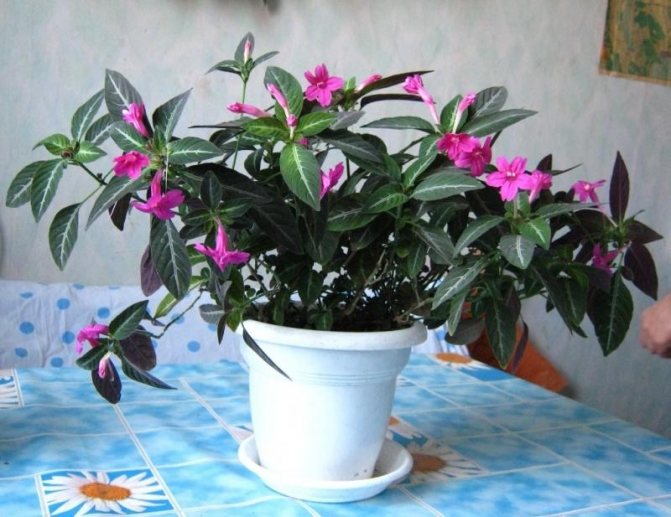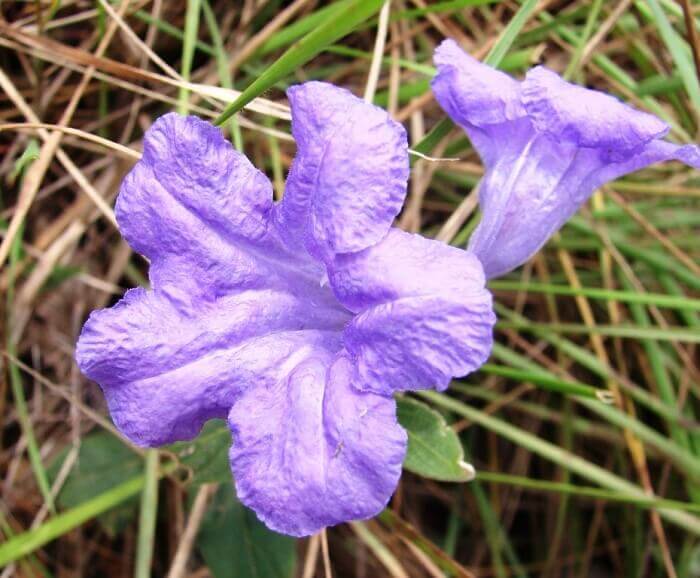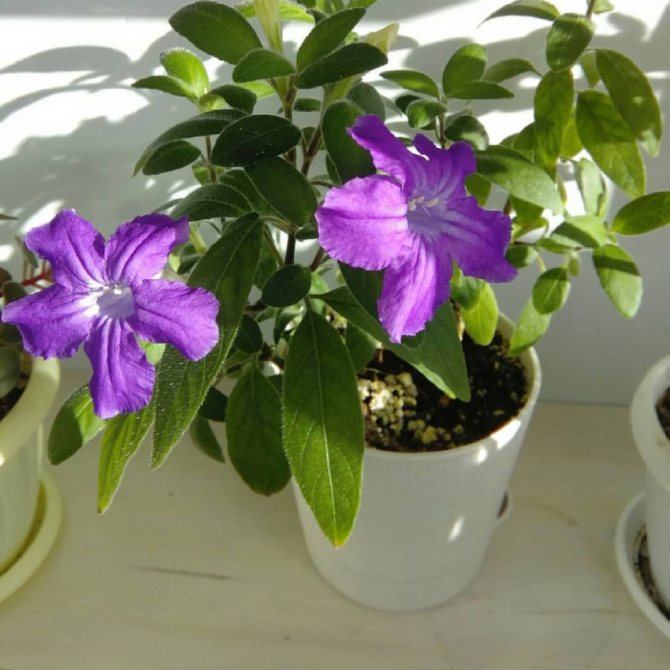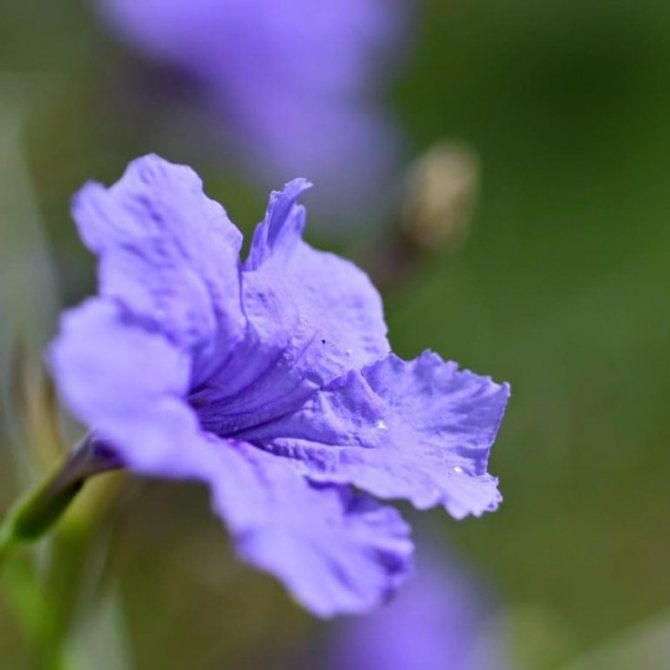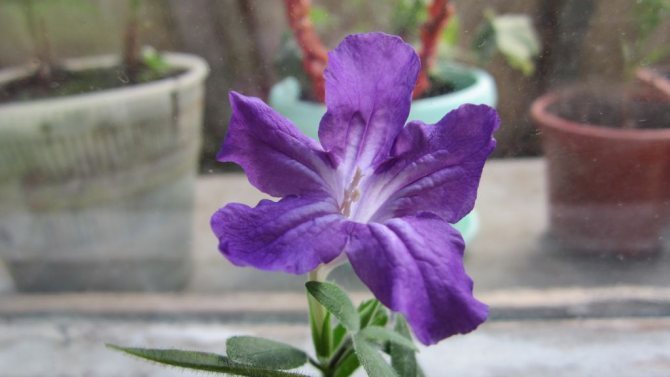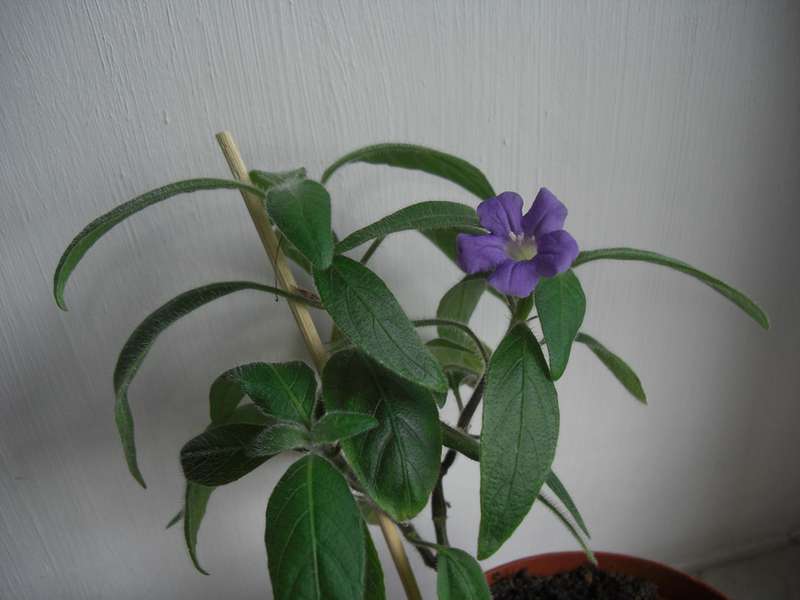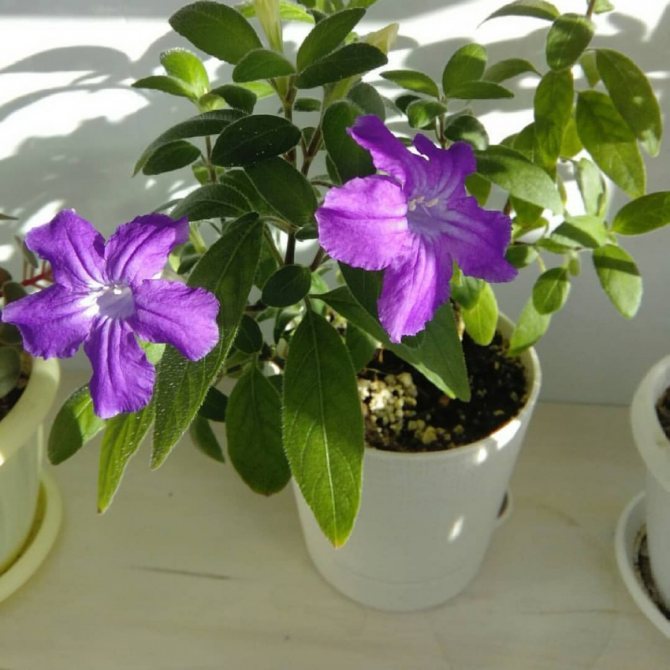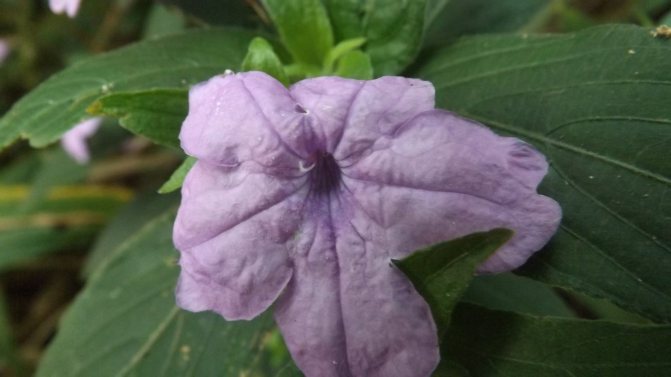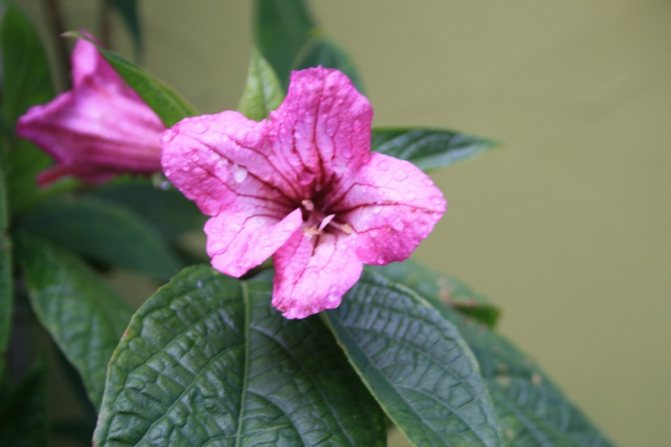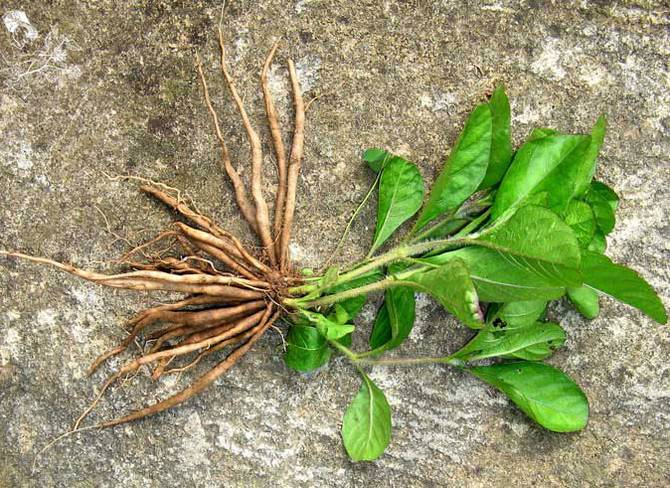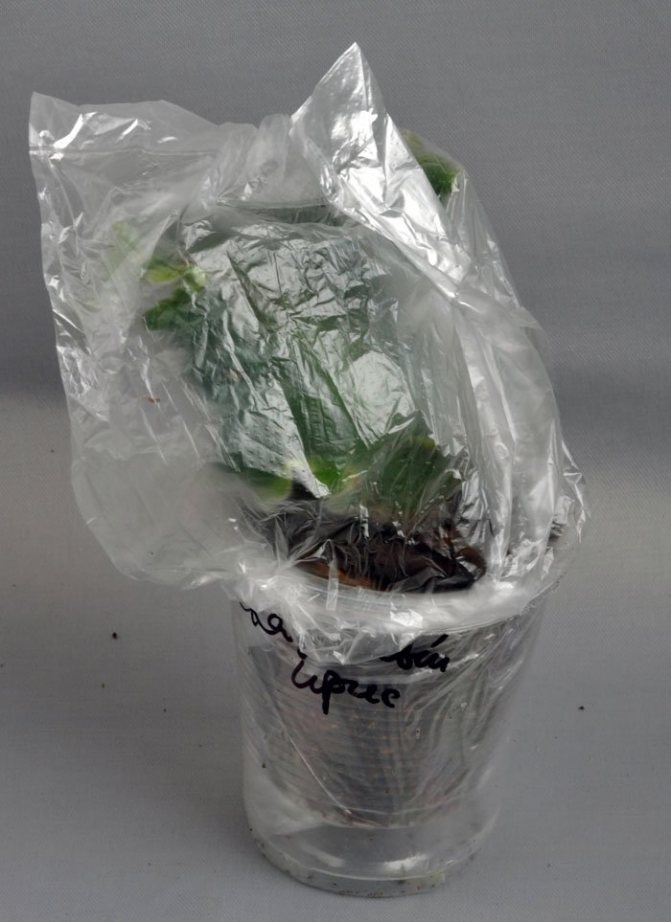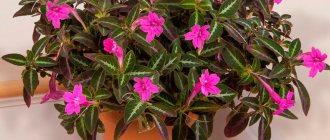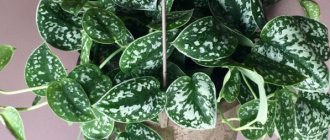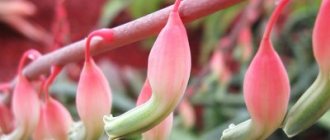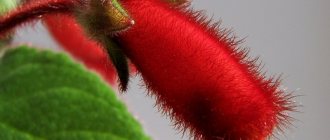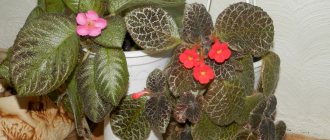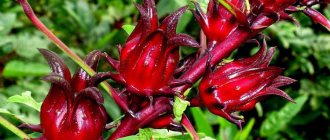Plants from the home collection are four times shorter, but develop as intensively as the “wild” specimens. The shrub lives for a long time, but periodically needs rejuvenation, because over time, the shoots become thinner and bare. Ruellia can bloom throughout the summer.
The beauty of the plant consists not only in bright funnel-shaped flowers, but also in velvety leaves, "decorated" with light streaks. Brazil is considered the birthplace of ruella. The natural habitat is the tropical forests of America and Africa.
Be sure to check out the plant from the Beloperone and Whitefeldia acanthus families.
| High growth rate. The length of the shoots increases by about 0.25 m per year. |
| Ruellia can bloom throughout the summer. |
| Easy to grow plant. |
| Perennial. |
Description of ruelia
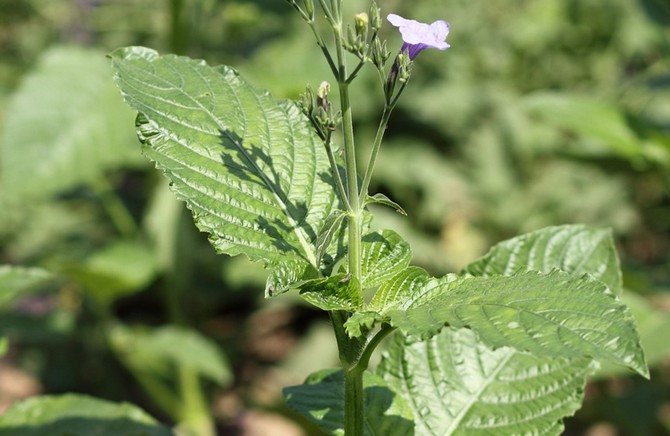
In the wild, the plant is found in Africa, South Asia, the subtropics and tropics of America. Ruellia is grown as a herbaceous plant, dwarf shrubs and shrubs. The flower has a straight, creeping or shallow stem, which has several faces and actively branches. Leaves are usually whole, whole, have an elongated shape and are wide in the middle. The leaves are located opposite each other and have a glossy sheen or a velvet surface with barely noticeable hairs.
At the ends of the shoots, single large flowers appear, which can reach up to 5 cm in length. Ruellia flowers are available in white, beige and purplish pink. Unfortunately, flowers do not last long - you can admire them for only a few hours. When the flower falls, a box of seeds appears in its place. It is interesting to observe how, after ripening, this capsule bursts, shooting its seeds at a great distance.
In bright and diffused light, ruelia can bloom from February to the very end of autumn. In a shaded room, flowering times are reduced to three to four months. The advantages of ruella include the fact that it can bloom in winter, when other plants are dormant.
Important! In most flower shops, you will not find ruelia. Probably due to the rapid flowering, it is not in great demand. But you can always try to find it in private collections of flower growers.
Caring for a ruelle flower at home
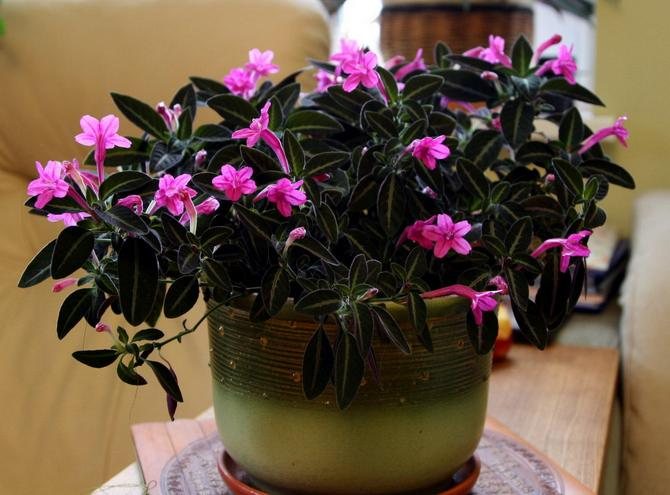

Ruelia does not require special care for her, so her cultivation and maintenance will not take much time.
Location and lighting
It is best to place ruelia on the east and west windows. The plant will bloom in the back of the room, but this requires sufficient lighting, since the ruelia requires a lot of light. Experienced growers use special lamps for plants in order for the plant to bloom all year round.
In the summer, it is important not to overexpose the plant in the sun, otherwise the leaves may simply burn out. In conditions of a lack of lighting, the length of the internodes of the plant will increase, and with intense lighting, the bush will bloom more actively and appear more luxuriant.
Temperature
As for the temperature, the most optimal temperature will be 18 degrees. In winter, the temperature is allowed to drop to 16 degrees.
Watering
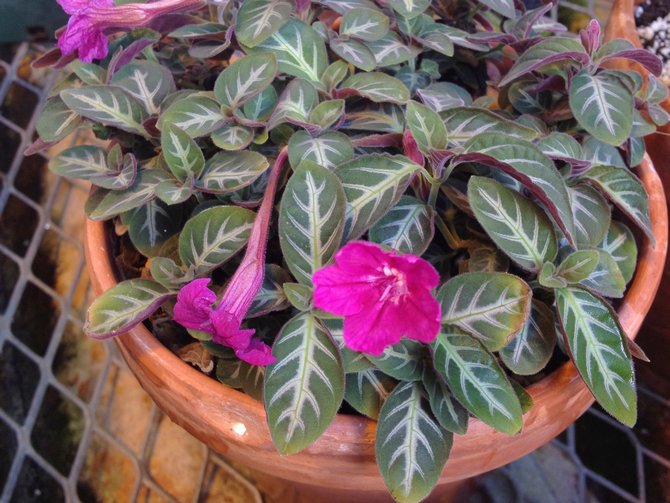

Every time the soil begins to dry out, the plant needs to be watered. Watering should be systematic, but not very plentiful. The plant needs water when the topsoil dries up. A situation should not be allowed when the whole earth is completely dry. As soon as the leaves begin to wither and fall, an urgent need to water the ruelia. Then there is a chance that the plant will bounce back if it has been without water for a short period of time. When the flower is left without watering for a long time, the lower leaves on the stem may fall off.
Air humidity
Ruellia does not require constant spraying. The main thing is that the flower is away from batteries, as well as heaters, since too warm air can stimulate the leaves to fall off the stem. Warm water is good for the plant.
Top dressing and fertilizers
When transplanting ruella, you need to add fertilizer to the soil for flowering plants. When the plant has acclimatized, a combined fertilizer for ornamental indoor plants can be added to the soil about 1-2 times a month.
Transfer
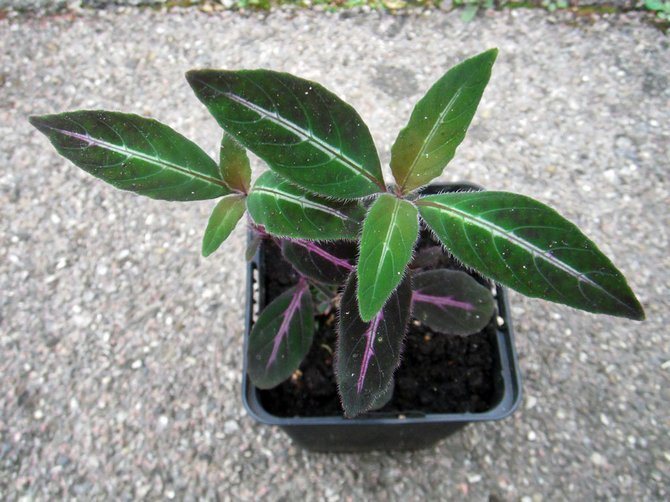

Young plants need to be replanted every year, and adults as needed. It is better to transplant between the beginning of March and the end of May. As a soil, you can use a mixture of sod and leafy soil, humus and sand. As an analogue of this mixture, you can use the usual commercial land for home plants. It will be very useful to put vermiculite in the soil, which will act as a drainage.
Pruning
To make the flower lush and actively branch, pinch the ruelia. For decorativeness and a beautiful appearance, naked shoots are cut off from ruelia, as a result of which new ones begin to form and the effect of splendor is achieved. Alternatively, you can plant a new plant by cutting off the top of the cutting.
Planting and transplanting procedure
Most often, the transplant for ruelia is carried out only once, moving the plants purchased from the store into a substrate and a pot suitable for them. It grows quickly, the shoots stretch out, "go bald", the number of buds is reduced. Therefore, most flower growers prefer to immediately update the flower by rooting the cuttings.
In general, ruelia grows rather quickly, therefore, it can exist in one pot for no more than two or three years, until roots appear from the holes in its bottom. It is best to carry out the procedure in early spring.
- The flower is undemanding to the quality of the soil. The only condition is that the soil must be loose, with good aeration. Acid-base balance is desirable neutral. You can use standard potting soil for those houseplants that are in bloom. Or mix it yourself from leafy soil, turf, turf and sand (2: 2: 1: 1). A useful additive is perlite or vermiculite (7-10% of the total volume). It makes the soil lighter.
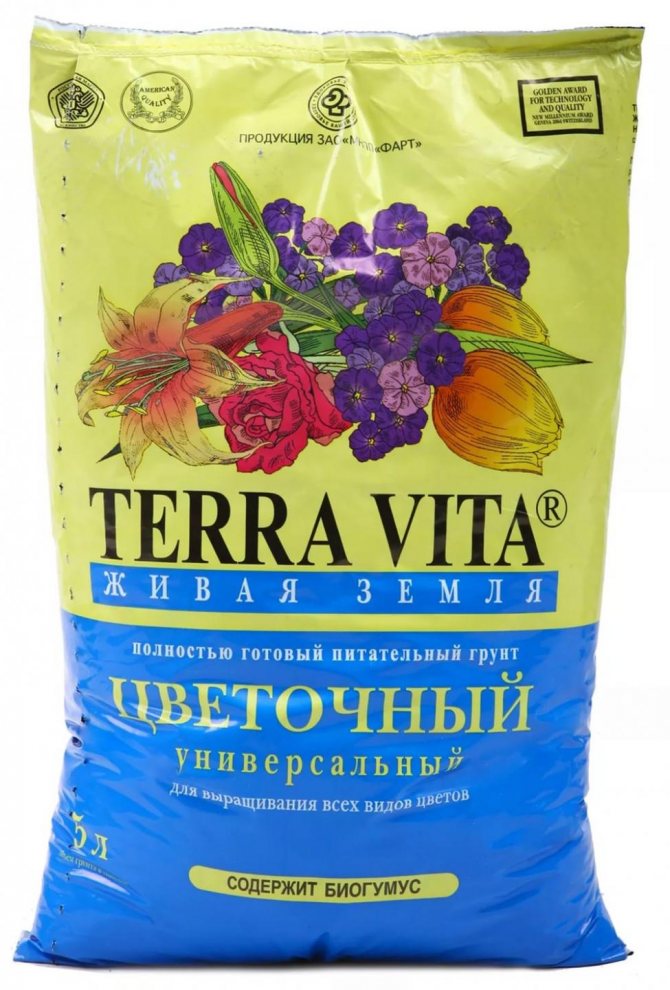

Ruella is undemanding to the quality of the soil, a universal soil mixture is quite suitable
- The new pot should be 5–7 cm larger than the old one. The root system of most ruelia species is shallow, so a shallow bowl-like container will do. It is desirable that it be made of unglazed ceramic for better air exchange.
- Ruella is transplanted by the transshipment method. Be sure to add a 2–3 cm thick drainage layer at the bottom of the new pot. The plant is removed from the old container, trying to destroy the earthen lump as little as possible, move it into a new container and add the substrate around the edges. If the roots are “compressed” from below into something that looks like felt, cut 2-3 mm with a sharpened sanitized knife. Then the soil is lightly tamped, the flower is not watered too abundantly and placed in partial shade for several days.During this time, it must be carefully protected from the bright sun.


Ruella is transplanted by the transshipment method
Reproduction of ruella
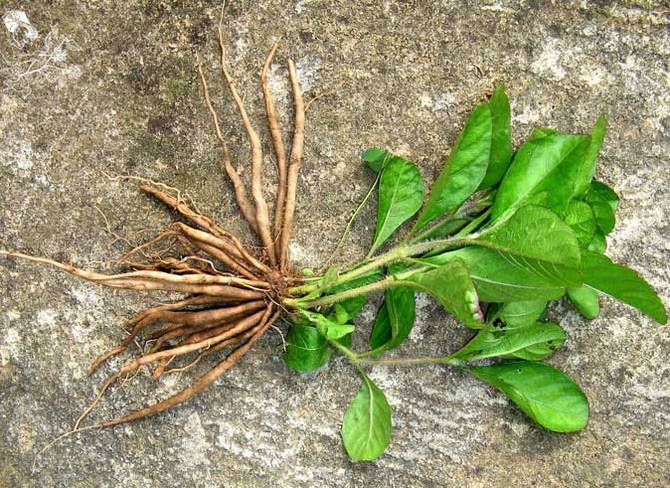

You can propagate ruella in different ways: by seeds, layering, cuttings or by dividing the bush.
Propagation by cuttings
When propagating by cuttings, it is important that they are not lignified. They need to be placed in water, and after a while the first roots will appear. Next, you need to plant them in the soil. The optimal amount is 5-6 cuttings per pot. Then the plants will appear more luxuriant.
Reproduction by layering
It is even easier to get new ruelle plants by layering. One of the shoots should be tilted to the soil so that one of the stem nodes touches the soil. Further, this place is fixed. After the roots appear, the layers are separated from the main flower.
Seed propagation
To obtain ruelia seeds, after ripening the fruits, you need to press a little on them, as a result of which it opens and seeds appear. They are planted in moist soil at a shallow depth.
Important! Ruella pleasant reproduces well enough with cuttings. With the help of cuttings, you can update the plant every year, so the ruelia will look much more beautiful.
Air humidity in the apartment
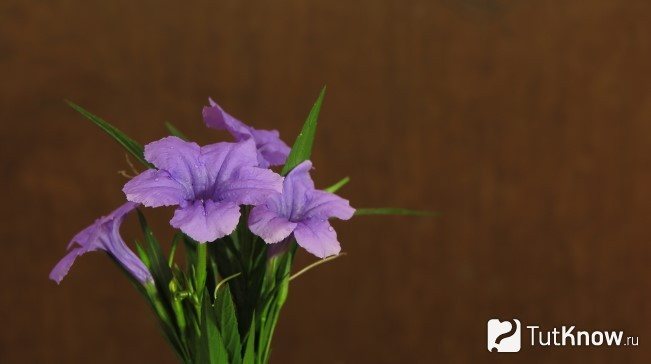

Growing ruelia requires constant moist air. Often, for this, they use a moisture sprinkler or put flower pots in deep containers, where expanded clay or peat soil is poured and water is poured so that it evaporates and increases the humidity in the air. During the heating seasons, hot and hot air is very destructive for ruella, so you need to try to reduce its contact with the flower, otherwise the leaves will begin to dry out and wrinkle. You can also spray the plant yourself, after which the flower begins to develop many young leaves and shoots. If you do not perform such actions, ruelia will lose a lot of green mass and cease to be attractive. In order to remedy the situation, you will have to get rid of the bare branches by pruning and then the plant will be able to start growing again.
If you want to get a beautiful plant, then there is a need to pinch it several times from early spring to July. Later, this does not need to be done, since it is possible to slow down the formation of buds.
What ruelia cannot stand is smoky rooms, you cannot smoke nearby and it is not recommended to put it in the kitchen, where there may be smoke from burning and food, soot.
Diseases and pests
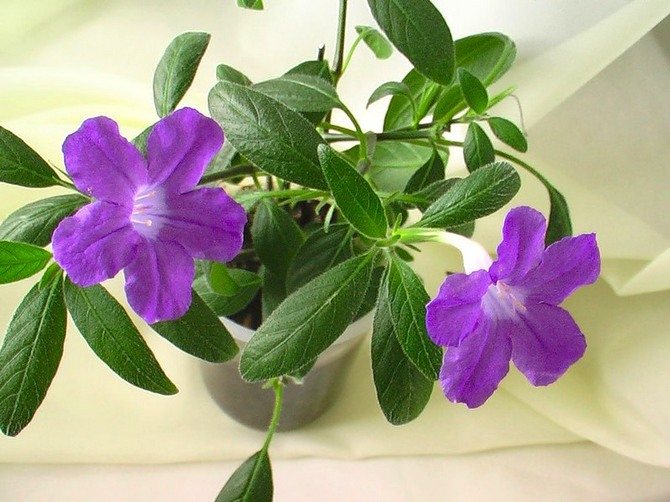

Ruellia resists various pests and diseases quite well, but it can be affected by the following parasites: spider mite - throughout the year, whitefly - mainly in summer. With excessive humidity and low temperatures, powdery mildew and gray rot most often appear.
Any insecticide is good against parasites, and to prevent diseases it is enough to keep the plant in good conditions.
Possible difficulties in growing ruelia
- Heat and excess sunlight can cause leaves to stain and curl. In this situation, it is enough to shade the plant or move it to a dimly lit place in the room.
- If the ends of the leaves dry up, then the plant needs a higher air humidity. Otherwise, the plant may get sick and stop blooming.
- Excessively elongated young shoots, small leaves and a nondescript flower may be the result of a lack of lighting. If there is not enough natural light, then you can buy special lamps for plants.
- Yellowed and falling leaves indicate excessive moisture in the soil or the plant is in a draft.
- Ruellia begins to grow over time: the stems stretch out, the leaves fall off - it is necessary to cut off the bare shoots, thereby renewing the plant.
Location of ruelia on the windows of the apartment
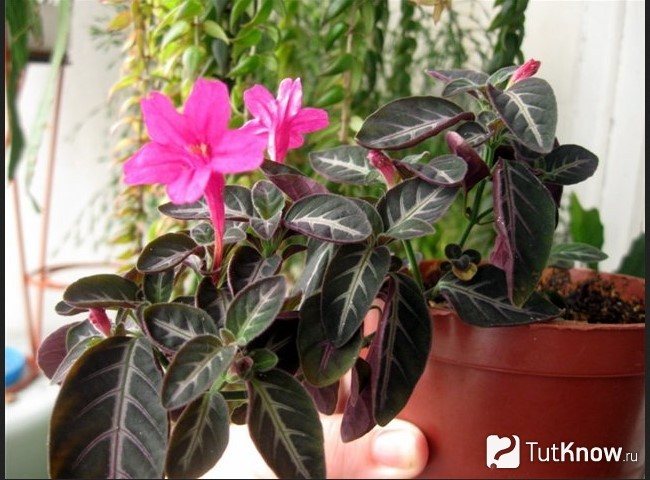

It is best to keep the ruella in a home or office environment with windows that are directed to the west or east, so that the sunlight is not bright and direct. If placed on a window facing north, the flower will lack lighting and the shoots will begin to stretch ugly, bud formation will not occur. But at the same time, the leaf plate acquires beautiful contrasting shades. Ruelia also has a negative attitude towards drafts - she can throw off all the leaves of the lower tier. If there is no way out, and you have to put a flowerpot on such a window, then you need to use special lamps to create the necessary illumination. The same procedure will have to be performed during the winter months, since 8 hour daylight will not be enough. When the flower pot is located on the south windows, it is necessary to ensure that the direct rays of the sun do not illuminate the ruelia. It is best to shade such lighting with light curtains (in extreme cases, with gauze).
Healing properties
Many types of ruella are often used in the preparation of medicines.
The juice is used to treat the ears, the decoction is used to relieve scabies and itching, the grated leaves are used to treat ulcers. The smoke from a burning plant can relieve headaches. The roots have stimulating and tonic properties.
In addition to its medicinal properties, ruelia can be dangerous - its juice contains the poison saponin.
If you decide to grow ruella at home, taking care of the flower will not be difficult, and you can always admire its large and bright flowers.
Popular types
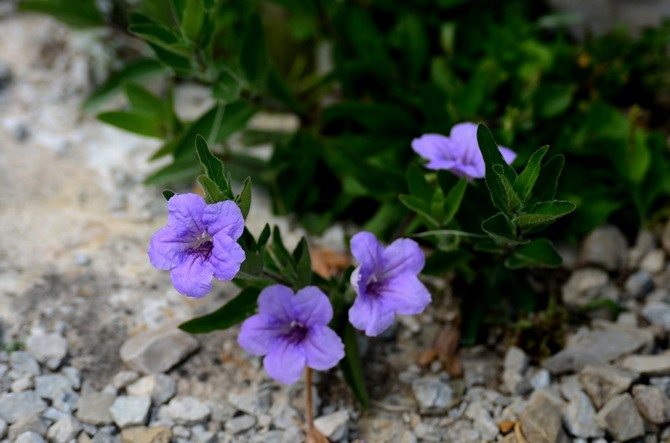

Ruellia Brittoniana - an evergreen shrub that grows up to 1 meter. The stems lignify at the base, long and wide leaves acquire a bluish tint under the influence of intense lighting. The plant has large flowers, the petals are purple. A feature of this species is the ability to grow it in colonies. The plant is unpretentious and is often grown in apartments.
Ruellia devosiana - grows mainly in the humid tropical forests of South America. Another name for the plant is Ruellia blue. The stem can grow up to 40 cm in height. The leaves are whole in the form of an ellipse, have a velvety surface, and a length of up to 7 cm. The upper surface of the leaf is dark green, the lower one is purple, the veins are whitish. The flowers are solitary, located in the leaf axils. They have a light lilac color with purple veins. The corolla at the fold is white or blue.
View of Ruellia portellae - grows in tropical rainforests of South America. The appearance of the plant is similar to blue ruella. The main difference is that Portella's ruella leaves are larger in size and brownish in color. In addition, the flowers are bright pink in color. This species can be grown as an unpretentious annual plant.
Ruellia large-flowered (Ruellia macrantha) - perennial abundant branching shrub, reaching a height of about 2 meters. Ruellia leaves resemble an ellipse, large - about 10-15 cm in length, sharpen at the very end. The corolla is tubular, like a bell, is rather large - about 8 cm wide and about 12 cm long. The flowers are located at the tops of the shoots, they can be red, pink and lilac. Flowering time - from autumn to spring, subject to additional lighting.
Houseplants Flowering Houseplants
Types of home ruella with photos and names
Of the whole variety of species of ruelia, only a few species are common in domestic culture.
Ruellia caroline (lat.Ruellia caroliniensis)
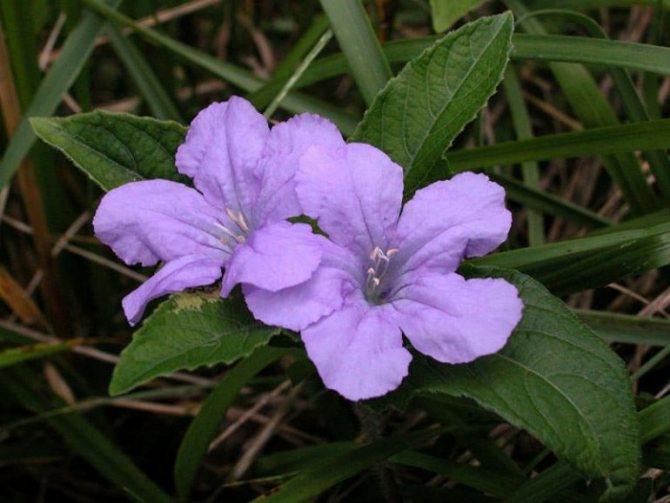

Low compact bush. Thin shoots are densely covered with malachite oval-elongated leaves with light veins. The surface of the leaves is velvety. Five-petalled tubular flowers are painted in bright lilac color.
Ruellia Devosiana, or Devosiana (lat.Ruellia Devosiana)
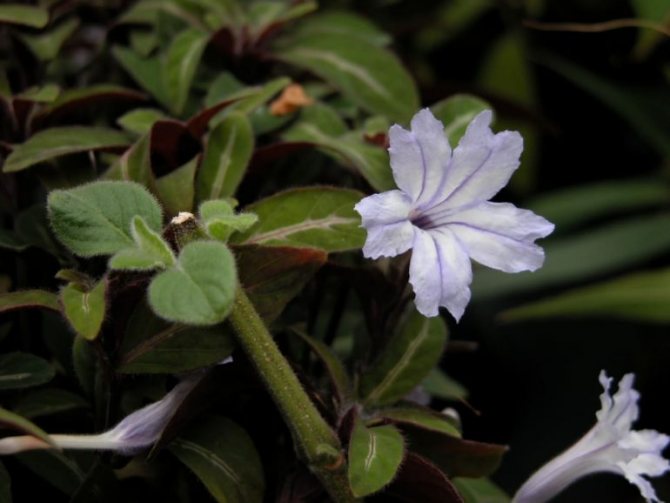

Ground cover shrub with thin shoots. Elongated bright green leaves can have a purple hue.The veins on the leaf blades are light and very distinct. Small white flowers have a lilac hue.
Related article: How to water flowers - when and what to water.
Ruellia Portella (lat.Ruellia portellae)
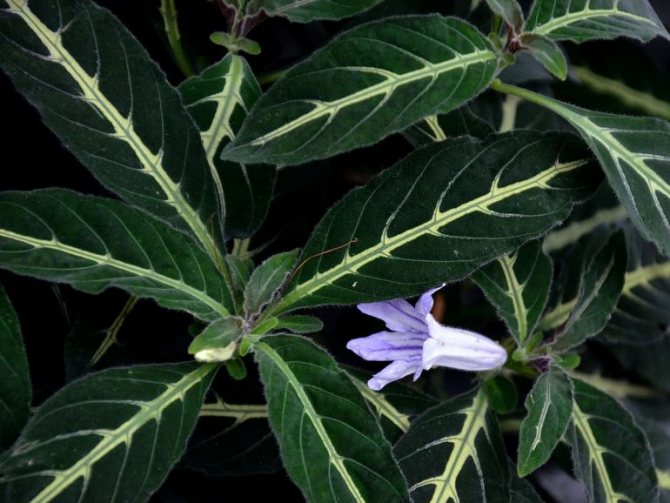

Ground cover shrub. Thin elongated shoots are decorated with oval large leaves, painted in a rich green color. The surface of the leaves has distinct light streaks. The flowers can be pink or purple.
Ruellia large-flowered (Latin Ruellia macrantha)
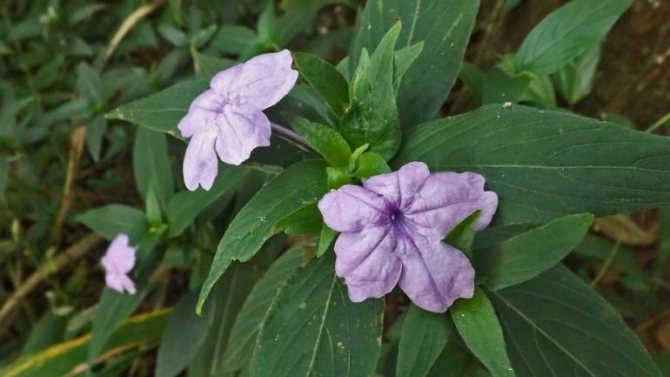

A short shrub with large flowers - bells, painted pink with clear vertical stripes. The leaf plates are narrow, elongated. Painted in light green tones with light streaks.
Ruellia pleasant (lat.Ruellia amoena)
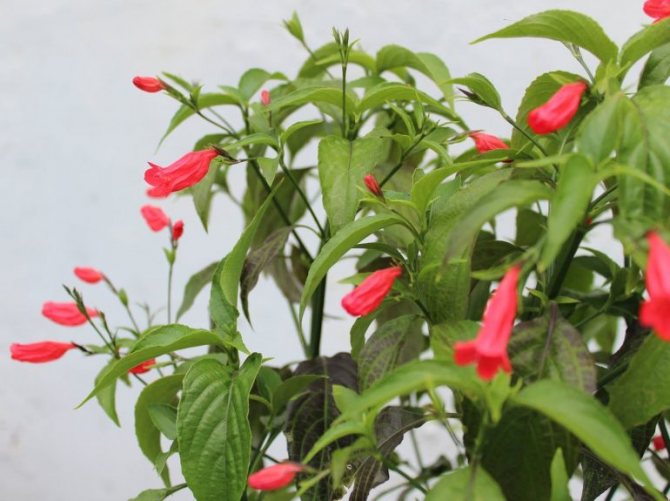

Compact shrub with pale green ovoid leaves and bright red or deep pink tubular flowers.
Mexican petunia, dipteracanthus, ruella - this plant is called differently. But in any case, with its discreet beauty and sophistication, the shrub attracts joy into the house.


